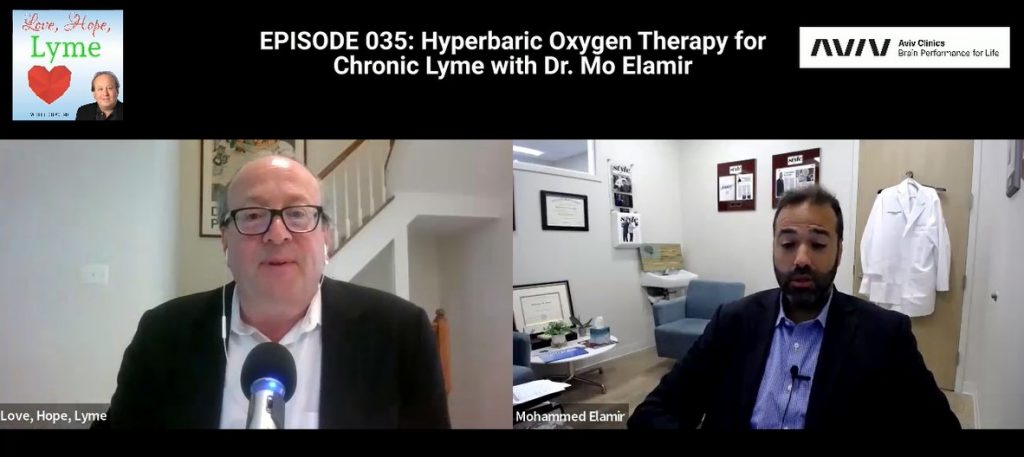PODCAST: Treating neurologic Lyme disease with hyperbaric oxygen

By Fred Diamond
Many listeners of my Love, Hope, Lyme podcast ask me to go deeper on some treatment topics that I mention in my book “Love, Hope, Lyme: What Family Members, Partners, and Friends Who Love a Chronic Lyme Survivor Need to Know.” One such topic is hyperbaric oxygen treatment (HBOT).
On today’s Love, Hope, Lyme podcast, Dr. Mo Elamir of the Aviv Clinics in Florida clarifies what HBOT is and how it may benefit those with persistent Lyme disease.
Breathing new life into Lyme treatment
Amidst the search for effective treatments, HBOT has emerged as a compelling approach, possibly offering new hope for those battling the persistent effects of chronic Lyme disease.
HBOT involves breathing pure oxygen in a pressurized environment. This method significantly increases the amount of oxygen in the blood, facilitating the body’s natural healing processes.
Dr. Elamir, a leading physician at Aviv Clinics, explains the transformative impact of HBOT on Lyme disease patients: “By increasing the oxygen levels in the body under pressure, HBOT can break through the biofilm that protects Lyme bacteria, which are often anaerobic and thrive in low-oxygen environments. This process can destroy the bacteria and lead to significant improvements in neurological function.”
The specific HBOT protocol used at Aviv Clinics involves fluctuating oxygen levels, a technique designed to trigger the body into a state of healing. This healing process includes the growth of new stem cells and blood vessels, improved mitochondrial function, and the repair of damaged brain tissue.
“Our approach is highly individualized, focusing on each patient’s unique needs and the specific ways Lyme has affected their neurological health,” says Dr. Elamir.
How Lyme impacts the brain
Lyme disease affects an estimated 60 million people worldwide in its chronic stage. The disease can invade various parts of the body, including the brain, where it causes a range of neurological symptoms.
These symptoms can be particularly challenging to diagnose and treat, often leaving patients in a state of cognitive fog, battling memory loss, and struggling with anxiety and depression.
Dr. Elamir provides critical insights into how Lyme disease can affect the brain. “The bacteria that cause Lyme disease, Borrelia burgdorferi, are spirochetes that can invade the brain, leading to symptoms such as brain fog, memory problems, anxiety, depression, and even issues with movement, coordination, and balance,” he explains.
“These symptoms can vary greatly from person to person, depending on how the disease affects their nervous system.”
One of the most challenging aspects of chronic Lyme disease is that its neurological effects are often dismissed or misdiagnosed.
“Standard tests like MRIs and nerve conduction studies may not reveal the subtle dysfunctions caused by Lyme,” Dr. Elamir points out. “As a result, many patients are told that their symptoms are ‘all in their head,’ leading to frustration and a sense of isolation.”
Stress: a catalyst for symptom reactivation
Stress plays a significant role in the reactivation of Lyme symptoms. Dr. Elamir explains that various stressors—whether physical, emotional, or even as minor as a common cold—can trigger the dormant spirochetes in the brain to become active again.
“Stress can cause these bacteria, which might have been lying dormant in the brain, to reemerge, leading to a resurgence of neurological symptoms,” he notes. This makes stress management a critical component of care for Lyme survivors.
The spirochetes’ ability to remain dormant and reemerge under stress is one of the reasons why Lyme disease can be so difficult to treat. Even after successful treatment with antibiotics, the bacteria can remain hidden in the body, waiting for an opportunity to resurface.
Comprehensive assessment and tailored treatment
At Aviv Clinics, treatment begins with a comprehensive assessment that spans three to five days. This in-depth evaluation includes structural and functional imaging of the brain, neurocognitive testing, and a thorough medical evaluation. One of the key tools used in this assessment is SPECT (Single Photon Emission Computed Tomography) scanning.
“SPECT scans allow us to see the metabolic function or dysfunction within the brain,” Dr. Elamir explains. “This is crucial because standard MRIs primarily show the structure of the brain, but SPECT scans give us a clearer picture of how Lyme disease has affected the patient’s neurological health.”
Based on the assessment, the clinic develops a personalized treatment plan that includes HBOT as a cornerstone therapy. But HBOT is just one component of a broader treatment protocol that also includes neurocognitive training, physical therapy, vestibular therapy (for balance issues), and psychotherapy.
Healing the mind alongside the body
Psychotherapy plays a crucial role in the recovery process for many Lyme survivors. As the brain begins to heal, patients may experience a resurfacing of traumatic memories or new psychological challenges. The clinic’s psychotherapists work closely with patients to help them navigate these changes and provide them with the tools they need to cope.
Cognitive Behavioral Therapy (CBT) is one of the most common forms of psychotherapy used at Aviv Clinics.
“CBT helps patients understand their symptoms, process their emotions, and develop strategies for managing anxiety, depression, and other psychological challenges,” says Dr. Elamir. Group therapy sessions are also offered, allowing patients to connect with others who are going through similar experiences.
The role of diet in neurological health
Diet is another critical aspect of treatment at Aviv Clinics. Dr. Elamir emphasizes the importance of following a diet that supports neurological health.
“One of the most effective diets for this purpose is the ketogenic diet, which has shown significant benefits for people with neurological conditions,” he says.
Originally developed for children with epilepsy, the ketogenic diet involves consuming high-fat, low-carbohydrate foods that induce a state of ketosis, where the body burns fat for fuel instead of carbohydrates. This can lead to improvements in brain function and a reduction in neurological symptoms.
Intermittent fasting is another dietary approach that can be beneficial for Lyme survivors.
“Intermittent fasting has been shown to improve metabolic processes and reduce inflammation, which can support the healing process in Lyme disease,” notes Dr. Elamir. This involves eating all meals within a specific window of time each day, such as an eight-hour period, and fasting for the remaining 16 hours.
Dr. Elamir also advises patients to reduce their intake of processed sugars, which can exacerbate inflammation and contribute to chronic health issues. “Minimizing sugar intake is essential in managing Lyme disease because it is characterized by chronic inflammation,” he explains.
Addressing co-infections
Co-infections are a common complication of Lyme disease. These are other infections transmitted by the same tick that carries Lyme disease, such as Bartonella and Babesia. These co-infections can cause their own set of symptoms and make the treatment of Lyme disease more complex.
“HBOT can also be effective in treating these co-infections,” says Dr. Elamir. “The increased oxygen levels can help destroy the bacteria responsible for these infections, while the overall treatment protocol supports the repair of any damage caused by the body’s immune response to the infection.”
Click here to listen to all episodes of the Love, Hope, Lyme Podcast or on YouTube.
Learn more about the Aviv Clinics here.
Fred Diamond is based in Fairfax, Virginia and can be contacted via Facebook. His popular book, “Love, Hope, Lyme: What Family Members, Partners, and Friends Who Love a Chronic Lyme Survivor Need to Know” is available on Amazon. The e-version of the book is always free to Lyme survivors. PM Fred on Facebook for your copy.





















We invite you to comment on our Facebook page.
Visit LymeDisease.org Facebook Page